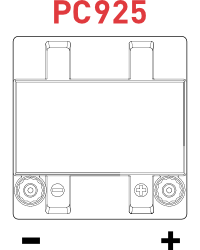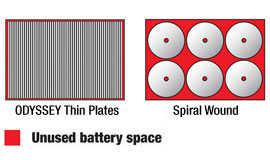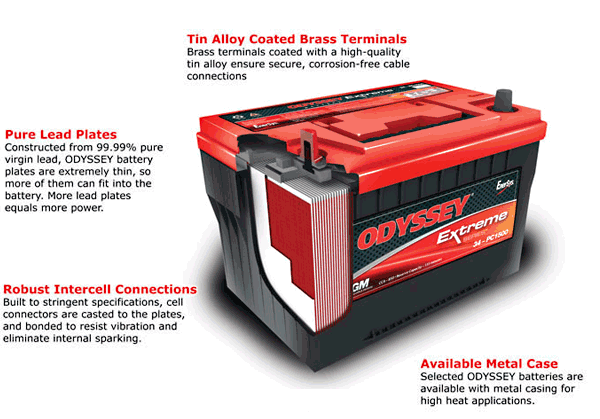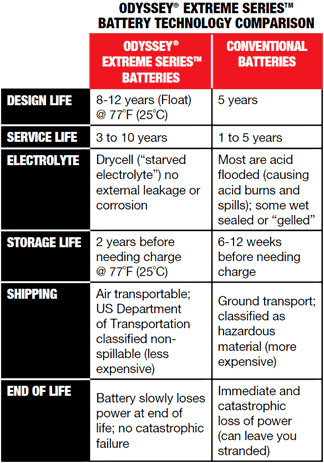Description


PC925 – 900A Pulse Current
Pulse Current or PHCA means the maximum output of the battery that is sustained for 5 seconds. After that the battery will output its cold cranking amperage (CCA for short) on a cold engine or it will output its hot cranking amperage (HCA for short) on a warm engine.
330CCA* 28Ah | 11.8Kg
Includes: internal threaded brass terminal with M6 SS bolts
610HCA**
Phenomenal starting power and massive deep cycle reserve power in one battery
Twice the overall power and three times the service life of conventional batteries
Some batteries offer enormous cranking power. Others deep cycle reserve power. Unbeatable ODYSSEY® Extreme Series™ batteries do both. Even at very low temperatures ODYSSEY Extreme Series batteries have the power to provide engine-cranking pulses in excess of 2250 amps for 5 seconds – double to triple that of equally sized conventional batteries. And they can handle 400 charge-discharge cycles to 80% depth of discharge.
Packed with more power
Like many popular spiral-wound batteries ODYSSEY Extreme Series batteries employ dry cell Absorbed Glass Mat (AGM) technology to contain acid allowing the battery to be installed even on its side. But the densely packed flat plates in an ODYSSEY Extreme Series battery avoid the “dead space” between cylinders in a “six pack” design. The result is 15% more plate surface area — and that translates to more power!
Odyssey batteries vs. spiral wound designs: 15% more plate surface area
How so much power is possible
ODYSSEY Extreme Series batteries are made with flat plates made of 99.99% pure lead – not lead alloy. Pure lead plates can be made thinner so we can fit more of them in the battery. More ODYSSEY battery plates mean more plate surface area. And that means more power – twice as much as conventional batteries.

Why Use ODYSSEY Batteries
Longer service life
- 3-10 years of service life to save you time money and aggravation
Longer cycle life
- 70% longer cycle life than conventional deep cycle batteries — high stable voltage for longer periods of time.
Longer shelf life
- Can be stored on open circuit (nothing connected to the terminals) without recharging for up to 2 years or 12.00V whichever occurs first.
Faster recharge
- The highest recharge efficiency of any sealed lead battery on the market — capable of 100% recharge in 4-6 hours.
Mounting flexibility
- Non-spillable design — can be mounted on any side in any position except inverted.
Vibration resistance
- Design protects against high impact shock and mechanical vibration — a common cause of premature battery failure.
Extreme temperature tolerant
- Operating temperatures from -40°C (-40°F) to 45°C (113ºF) for models without a metal jacket and from -40ºC (-40ºF) to 80ºC (176ºF) for models with a metal jacket.
Totally maintenance free
- No need to add water ever! Drycell design with resealable venting system.
Improved safety
- US Department of Transportation classified as a ‘non-spillable’ battery. No acid spills no escaping gases.

For Engine Starting:
For Running Equipment:
*Cold Cranking Amperes (CCA)
The CCA is an indicator of the power the battery can deliver for engine start when the engine is cold (i.e. the first start of the day). Consequently bigger engines usually require higher CCA values to operate. CCA is measured in Amperes under normalised conditions (discharge at -18ºC keeping battery voltage over a minimum value) according to the standard EN50342-1.
**Hot Cranking Amperes (HCA)
Hot Cranking Amps (HCA) basically refer to the amount of current a battery can provide at 26° C. The definition includes the amps the battery can deliver and maintain for 30 seconds at the minimum of 1.2 volts per cell.










